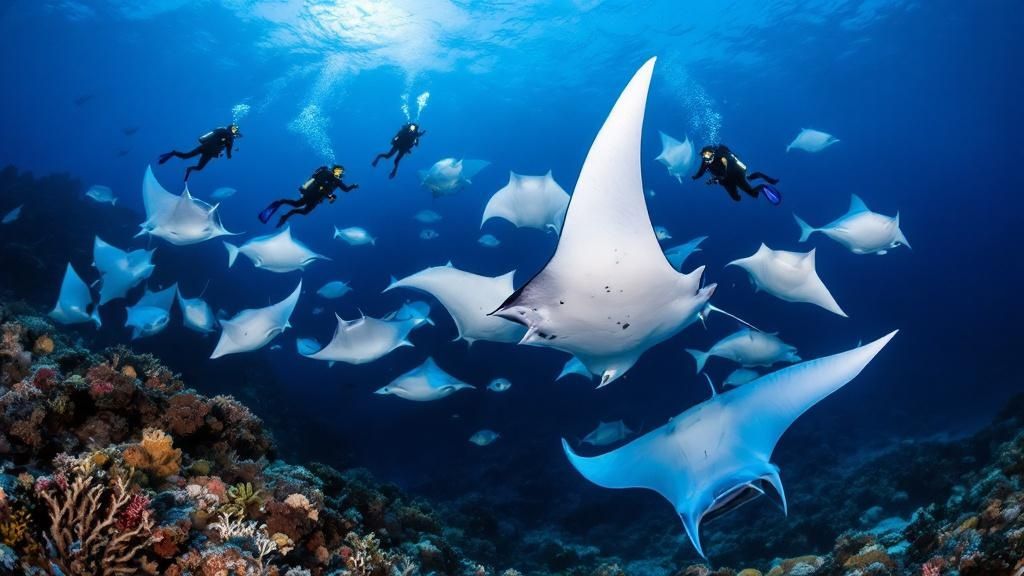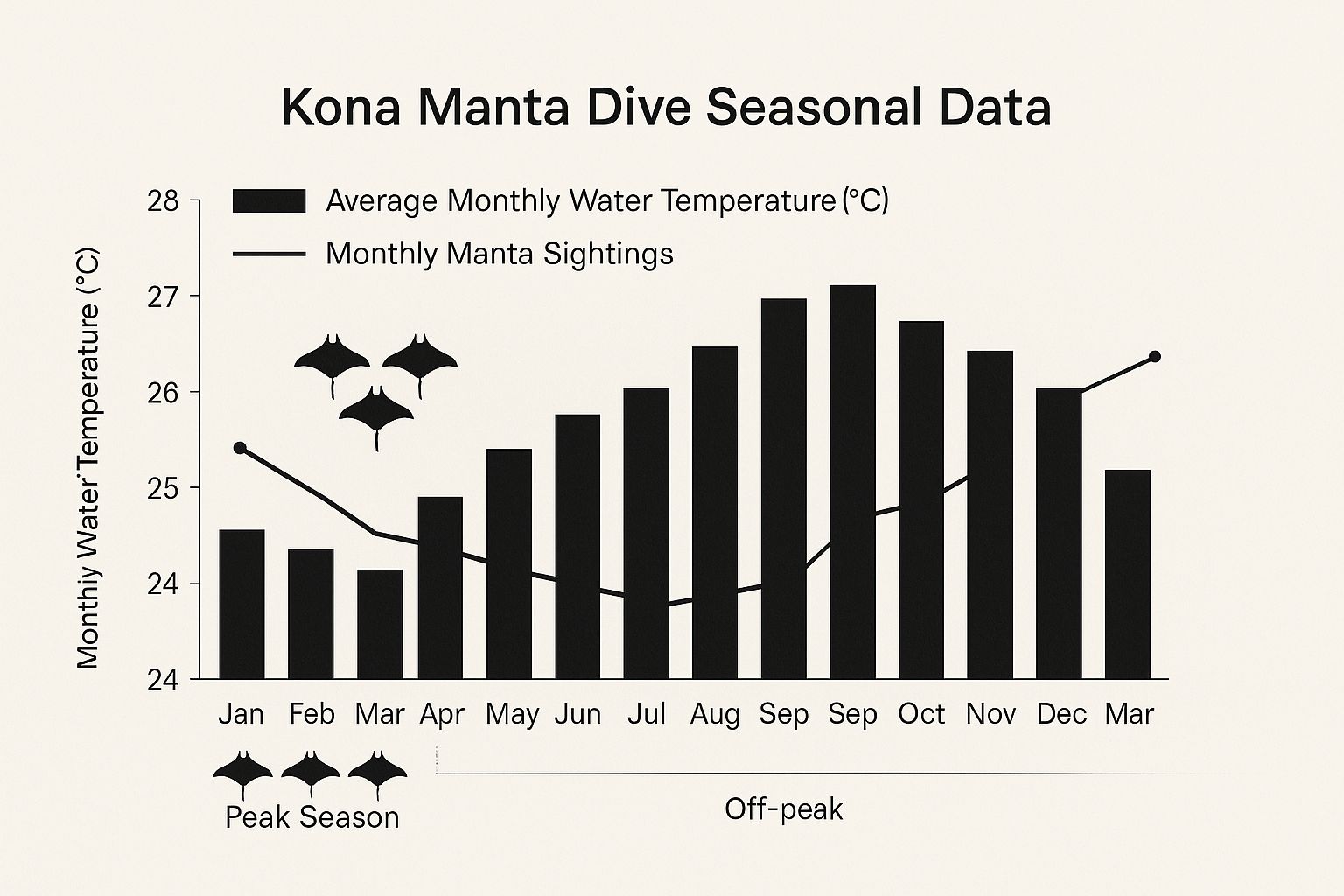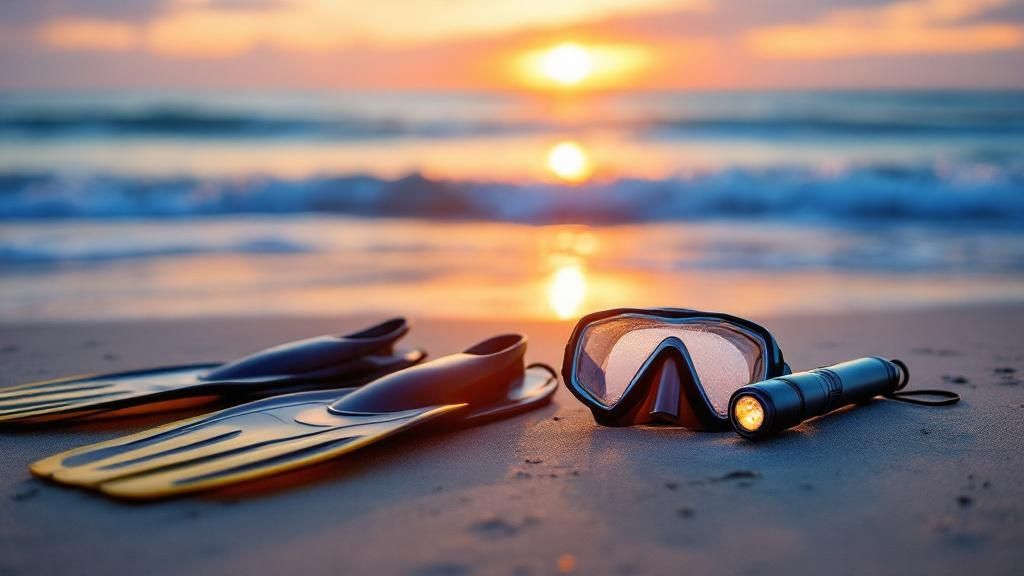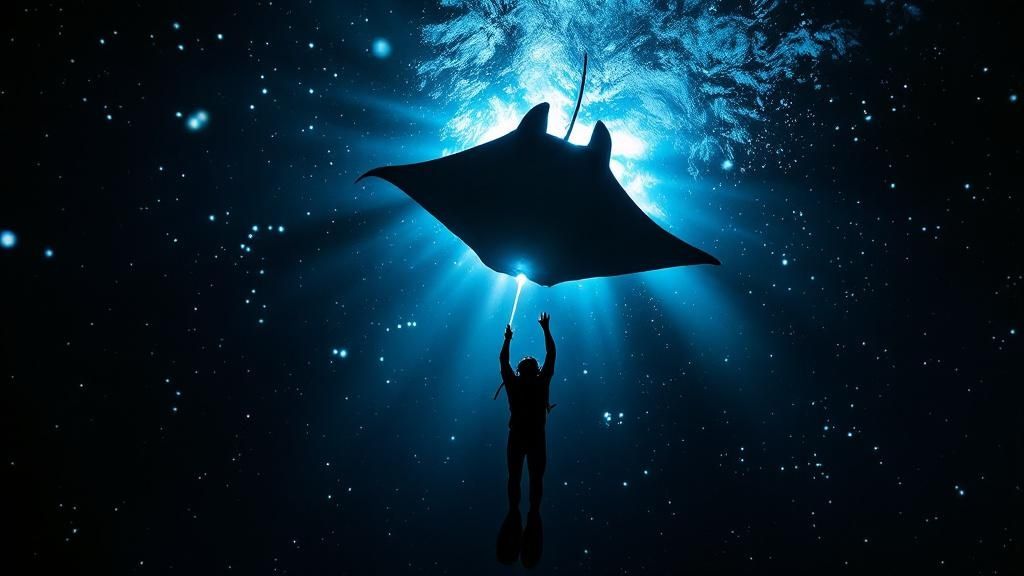Why Kona Dominates The Global Manta Ray Scene
Kona, Hawaii, isn't just a typical dive destination; it's the premier spot for manta ray encounters. What sets it apart? A unique combination of factors creates a perfect habitat, attracting these gentle giants year-round. The volcanic topography of the Kona Coast is key. These underwater formations create ideal conditions for plankton blooms, the manta ray's main food source.
This plentiful food supply is a primary reason manta rays consistently choose Kona's waters. Volcanic slopes and ocean currents work together, funneling plankton to the surface for an easily accessible feast. Specific sites like Manta Village and Manta Heaven are famous for these predictable feeding gatherings. These locations offer divers and snorkelers virtually guaranteed sightings, making Kona a global manta ray tourism hotspot. Interested in learning more? Check out this article: Why should you go on a manta ray dive in Kona?
The Impact of Kona's Unique Ecosystem
The nutrient-rich waters around Kona are crucial to this thriving ecosystem. Combined with the distinctive underwater topography, they create the perfect environment for plankton to prosper. This, in turn, attracts large numbers of manta rays, making Kona an exceptional location for encounters. Kona stands out as a top destination for manta ray experiences. For more on what makes it so special, read this article: Manta Ray Dive Kona Epic Hawaiian Adventure.
The popularity of manta ray night dives has exploded, with approximately 80,000 participants each year. This makes Kona the world's leading destination for manta ray encounters, boasting an impressive sighting success rate between 80% and 90%. Delve deeper into the numbers with this resource: Kona manta ray statistics.
Conservation Efforts and Responsible Tourism
Dedicated conservation efforts in Kona play a vital role in safeguarding this incredible ecosystem. Local organizations and tour operators collaborate to promote responsible tourism, ensuring manta ray encounters are sustainable and minimize disruption to the animals and their environment.
This commitment to conservation helps maintain the delicate balance of Kona's marine environment. It ensures future generations can also witness the magic of these gentle giants. This responsible approach distinguishes Kona from other destinations and solidifies its position as a leader in manta ray ecotourism.
The Fascinating Science Behind Manta Behavior
Manta rays aren't just random visitors to Kona. Their presence is rooted in predictable behavioral patterns driven by the area's unique ecosystem. These gentle giants have evolved specific feeding strategies, social structures, and seasonal movements that make Kona a reliable hotspot for manta dive experiences. Plankton, their primary food source, thrives in Kona's nutrient-rich waters, creating a consistent draw for these filter feeders.
Tracking and Identifying Individual Mantas
Researchers use innovative identification methods, similar to fingerprint recognition, to track individual manta rays. Each manta has unique spot patterns on its underside. This allows scientists to monitor their movements and behaviors over time. Some individuals have even been tracked for over a decade, providing invaluable data on their life cycles and habits.
This long-term tracking has revealed crucial insights into their migration patterns and social interactions, enhancing our understanding of these magnificent creatures. From 2009 to 2014, a dedicated research team meticulously documented manta ray sightings six to seven nights a week at "Manta Village" and "Manta Heaven." These detailed records not only tracked individual rays but also monitored their health and movements. You can find more detailed statistics here: Manta Ray Statistics.
Environmental Influences on Manta Activity
Several environmental factors significantly influence manta ray activity. Lunar cycles, weather patterns, and plankton blooms all play a role in where and when mantas congregate. Learn more about manta ray night dives. Understanding these influences helps predict optimal viewing times and locations, maximizing your chances of an unforgettable manta dive Kona experience. For example, reduced moonlight can increase plankton visibility, drawing mantas closer to the surface during night dives.

This means factors like water temperature and current patterns can significantly impact the predictability of manta ray sightings. By combining scientific research with local knowledge, dive operators can offer truly remarkable and consistent manta ray encounters in Kona. This understanding not only enhances the diving experience but also promotes responsible tourism that respects these incredible animals and their environment.
Choosing Your Perfect Manta Dive Experience
Picking the right manta ray dive tour in Kona can truly elevate your trip. This guide will help you explore the options and choose the perfect encounter based on your experience level and what you're hoping to see. We'll break down the differences between diving and snorkeling, daytime and nighttime excursions, and smaller groups versus larger tours. This way, you'll be ready to make informed decisions and have the best possible manta ray experience.
Diving vs. Snorkeling: Which is Right for You?
Certified divers can choose a scuba dive, allowing them to fully immerse themselves in the manta rays' underwater world. This offers a closer look and more time on the bottom, giving you ample opportunities to watch these gentle giants up close. For those who prefer to stay near the surface, snorkeling is a fantastic option. Snorkeling is easy for people of all ages and experience levels, offering incredible views of the mantas gliding through the water from above.
- Scuba Diving: Provides closer interaction and a 360-degree perspective, but requires scuba certification.
- Snorkeling: Accessible to all, offers surface views of the mantas.
Day vs. Night: A Tale of Two Experiences
Manta ray encounters in Kona are available during the day and at night, each offering a unique perspective. Daytime viewing allows you to appreciate the mantas’ subtle colors and observe their natural behaviors in the sunlight. However, the real magic happens at night. Special lights attract plankton, bringing the mantas closer to the surface for a truly remarkable feeding display.
- Daytime: See their natural behavior and coloration.
- Nighttime: Witness the captivating plankton feeding frenzy.
Group Size and Tour Operator Considerations
Your experience is also shaped by the size of your group and the tour operator you select. Small groups provide a more personalized experience, with added flexibility and individual attention. Larger groups can offer a lively social atmosphere and are usually more budget-friendly. When choosing a tour operator, be sure to check their safety record, their commitment to sustainable practices, and their cancellation policy.
To help you compare the various manta ray encounter options, take a look at the table below:
Manta Dive Options Comparison: Detailed comparison of different manta ray encounter options including diving vs snorkeling, group sizes, duration, and experience requirements
| Experience Type | Experience Level Required | Duration | Group Size | Best For |
|---|---|---|---|---|
| Scuba Diving (Day) | Certified Diver | ~45-60 minutes underwater | Varies by operator (typically 4-8 divers per guide) | Close encounters, underwater photography |
| Scuba Diving (Night) | Certified Diver | ~45-60 minutes underwater | Varies by operator (typically 4-8 divers per guide) | Plankton feeding frenzy, unique experience |
| Snorkeling (Day) | None | ~30-45 minutes in the water | Varies by operator (can be larger groups) | All ages and abilities, surface viewing |
| Snorkeling (Night) | None | ~30-45 minutes in the water | Varies by operator (can be larger groups) | Plankton feeding frenzy, accessible to all |
As you can see, there's an option for everyone. Divers will enjoy the extended time and closer proximity to the mantas, while snorkelers will appreciate the ease of access. Night dives offer a particularly unique and captivating experience.
Timing Your Dive and Understanding Seasonal Data

The infographic above displays Kona Manta Dive Seasonal Data, outlining average monthly water temperature, manta sighting frequency, and highlighting peak and off-peak seasons. Manta rays are present year-round. However, sightings are most common between December and March, coinciding with slightly cooler water temperatures and higher plankton concentrations. The summer months offer calmer waters, but planning your trip during peak season improves your chances of an amazing encounter.
By weighing these different aspects, you can customize your Kona manta ray dive experience to your own preferences and create memories that will last. Whether you're an experienced diver or a first-time snorkeler, Kona offers a magical manta ray encounter for everyone.
What Really Happens During Your Manta Adventure
Forget the glossy brochures. Let's dive deep into a typical manta ray dive experience in Kona, from the moment you step onto the boat to the unforgettable memories you'll make. This guide will walk you through everything you can expect on your adventure.
Setting Sail and Pre-Dive Prep
Your manta adventure begins with boarding the boat. Most evening manta dives leave just before sunset, giving you a chance to soak in the scenic Kona coastline on your way to the dive site. Once aboard, you'll receive a professional briefing covering essential safety procedures, the proper etiquette for interacting with manta rays, and a preview of the dive itself. This briefing is crucial for both your safety and the well-being of the mantas. You might be interested in: Our Kona manta ray night dive guide.
Next, it's time for equipment fitting. Whether you're snorkeling or scuba diving, the crew will assist you in finding the right gear for a comfortable and secure experience. Wetsuits, snorkels, masks, fins, and other necessary equipment are usually provided. This personalized attention ensures you're completely comfortable throughout your adventure.
Entering the Manta's Realm
As darkness settles, you'll arrive at the dive site, often Manta Village or Manta Heaven, locations renowned for their consistent manta ray sightings. The boat positions itself strategically, and divers and snorkelers enter the water, congregating around the submerged dive lights. These lights attract plankton, creating a captivating feeding ground for the mantas.
Now, the real magic unfolds. Massive, graceful manta rays glide through the illuminated water, sometimes just inches below you. While touching them is strictly prohibited to protect their sensitive mucous layer, their close proximity is awe-inspiring.

Proper Positioning and Underwater Etiquette
Positioning yourself correctly is key to enjoying the best possible views. Divers typically kneel on the ocean floor, while snorkelers float on the surface, both maintaining a respectful distance from the mantas. This arrangement ensures everyone has an unobstructed view of the mesmerizing manta ballet without disturbing the animals.
Remaining calm and respectful is paramount during these close encounters. Avoid sudden movements or using flash photography, as these can disorient the mantas. Simply relax and observe their graceful movements.
Water Temperature, Visibility, and Weather Considerations
The water temperature in Kona is generally comfortable, averaging between 77-82°F (25-28°C). However, a wetsuit is recommended for extra warmth, especially at night. Visibility is typically excellent, offering breathtaking views of the mantas.
Occasionally, weather conditions can affect dive plans. Reputable operators prioritize safety and will cancel or reschedule trips if necessary. This highlights the importance of selecting a reliable tour operator with clear safety protocols.
Returning to Shore: Memories Made
As your manta adventure draws to a close, you'll return to the boat, filled with excitement. The experience of witnessing these gentle giants up close is truly unforgettable. The boat ride back provides a perfect opportunity to share stories and reflect on the magical encounter, leaving you with cherished memories that will last a lifetime.
Understanding Kona's Incredible Success Rates
The impressive manta ray sighting statistics you see for Kona aren't just marketing; they reflect genuine, documented success. This sets realistic expectations for your manta ray dive experience in Kona. Let's explore the data behind these exceptional sighting rates and what makes them so consistent.
Deconstructing the Success Rate
What does an 85-90% success rate mean for your Kona manta ray adventure? It means on most dives, you have a very high chance of encountering these magnificent creatures. This reliability isn't luck; it's a testament to Kona's unique conditions and the expertise of local dive operators. Professional operators enhance these already high odds through careful site selection, optimal timing, and in-depth knowledge of the area. Find more detailed statistics here.
The reliability of manta ray encounters has earned Kona a reputation for nearly guaranteed wildlife viewing. Dive operations like Jack's Diving Locker report successful sightings on 85-90% of all outings. This consistency is unique to Kona, as other manta ray destinations can’t promise similar odds.
Factors Behind the Reliability
Several factors contribute to Kona's consistent success. The abundance of plankton, the manta ray's primary food source, is key. Kona's volcanic slopes and ocean currents create the ideal environment for plankton, providing a constant feast for the mantas. You might be interested in: What it's like to go on a manta ray dive in Kona, Hawaii.
Expert dive operators also know the best viewing spots and times. They use their deep understanding of manta ray behavior and local conditions to maximize your chances. For example, they often choose dive sites like Manta Village and Manta Heaven, known for consistent manta ray activity.
Backup Strategies and Seasonal Variations
Even with high success rates, there are rare times when mantas can be harder to find. Professional dive operators have backup strategies, like alternative dive sites or adjusted dive times, to ensure a memorable experience. Understanding seasonal variations in manta ray activity can also improve your chances. While mantas are present year-round, certain times, like winter, may have slightly lower visibility due to weather. Dive operators adapt their strategies to these changes, maximizing your chances of a successful encounter.

This combination of natural factors, expert guidance, and adaptable strategies makes manta ray dives in Kona so exceptional. This reliability has solidified Kona's reputation as a world-leading manta ray destination, offering a nearly guaranteed wildlife encounter that truly lives up to the hype.
Smart Preparation For An Extraordinary Experience
Proper preparation enhances any manta ray dive, turning a good experience into a truly unforgettable one. This guide covers essential pre-dive information for exploring Kona's waters, from physical fitness to the mental aspects of a nighttime encounter with these graceful giants.
Ensuring Your Safety and Comfort
Safety is paramount for professional manta dive operators in Kona. They follow rigorous protocols, including detailed pre-dive briefings, established emergency procedures, and diligent equipment maintenance. These measures ensure your well-being in the sometimes challenging conditions of a night dive.
- Pre-Dive Briefing: These briefings cover essential safety guidelines, proper manta ray interaction etiquette, and specific details about the dive site.
- Emergency Procedures: Operators review clear protocols for handling any unforeseen situations, ensuring a swift and appropriate response to any potential issue.
- Equipment Check: Dive operators meticulously maintain their equipment, providing divers with well-maintained wetsuits, snorkels, masks, and fins.
For more information about night diving in Kona, check out this article: 5 Reasons Why You Should Try Kona Diving at Night.
Physical and Mental Preparation
While manta ray diving in Kona doesn't demand peak athleticism, a reasonable fitness level ensures a more comfortable and enjoyable experience. You should be able to swim and tread water with ease. Mentally preparing for entering the ocean at night is also beneficial. Visualizing the experience and practicing slow, deep breathing can help manage any pre-dive jitters.
- Fitness: Ensure you're comfortable swimming and floating.
- Mental Preparation: Visualizing the dive and practicing deep breathing techniques can help alleviate anxiety.
What to Bring and What’s Provided
Most operators furnish the necessary equipment, such as wetsuits, masks, snorkels, and fins. Bringing a few personal items can further enrich your experience. A waterproof camera helps capture the magic of the encounter. Packing a towel and dry clothes ensures post-dive comfort. If prone to seasickness, consider bringing appropriate medication after consulting with a doctor.
To help you prepare, here's a comprehensive checklist:
Pre-Dive Preparation Checklist: Comprehensive checklist covering physical preparation, required items, safety considerations, and conservation guidelines for manta diving
| Category | Requirement | Why It Matters | Provided by Operator |
|---|---|---|---|
| Physical Preparation | Comfortable swimming and treading water | Essential for a relaxed dive experience | N/A |
| Physical Preparation | Manage any pre-dive anxiety with visualization and deep breathing | Enhances enjoyment and reduces stress | N/A |
| Required Items | Waterproof Camera | Capture the unforgettable encounter | No |
| Required Items | Towel and dry clothes | Post-dive comfort | No |
| Required Items | Seasickness medication (if needed) | Prevents discomfort during the boat ride and dive | No |
| Safety Considerations | Attend pre-dive briefing | Learn essential safety procedures and manta ray interaction guidelines | Yes |
| Safety Considerations | Familiarize yourself with emergency procedures | Be prepared for unexpected situations | Yes |
| Provided Equipment | Wetsuit, mask, snorkel, fins | Essential gear for the dive | Yes |
This checklist summarizes the key elements to prepare for, ensuring you're ready for an amazing experience. Remember to consult your operator for specific requirements and recommendations.
Conservation Guidelines for a Responsible Experience
Responsible wildlife interaction is vital for preserving the manta rays and their fragile habitat. Avoid touching the mantas, as this can damage their protective mucous layer. Refrain from using flash photography, which can disorient them. Always heed your guide's instructions. Following these guidelines contributes to the long-term health of this incredible ecosystem. Understanding these practices enhances both your safety and the overall quality of your dive.
Maximizing Your Manta Dive Investment
Your manta ray dive in Kona is more than just a vacation activity; it's an investment in a truly unforgettable experience. To make the most of this investment, consider these strategies for enhancing your adventure before, during, and after your dive.
Timing Your Trip for Optimal Conditions
While manta rays grace Kona's waters year-round, understanding seasonal nuances can significantly enhance your viewing experience. The period between April and October generally offers calmer waters and increased visibility, ideal for both snorkeling and diving. However, manta rays are present year-round, and even the winter months offer unique opportunities. The winter plankton blooms can draw mantas closer to the surface.
Complementary Big Island Experiences
Your manta dive is a fantastic centerpiece, but the Big Island has so much more to offer. Explore the volcanic landscapes of Volcanoes National Park, hike through lush rainforests, or unwind on pristine beaches. Consider a visit to the Mauna Kea Observatories for unforgettable stargazing, or explore local coffee plantations for a taste of Kona's famous brew.
- Volcanoes National Park: Witness active volcanoes and unique geological formations.
- Mauna Kea Observatories: Explore the cosmos at world-renowned observatories.
- Kona Coffee Plantations: Discover the process from bean to cup.
Extending the Magic: Post-Dive Activities
After your incredible manta ray encounter, extend the magic with other marine activities. Consider a daytime snorkel or dive to explore Kona's diverse coral reefs teeming with vibrant fish. Whale watching tours are also popular, especially during the winter months when humpback whales migrate to Hawaiian waters. Prepare for your manta ray night snorkel with this helpful guide: Kona Manta Ray Night Snorkel.
- Daytime Snorkeling/Diving: Explore Kona’s vibrant reefs.
- Whale Watching Tours: Witness the majestic humpback whales (seasonal).
Capturing the Moment: Photography Tips
Invest in high-quality underwater photography equipment to capture the beauty of your manta dive. A GoPro or similar action camera with underwater housing is an excellent choice. A red filter will enhance colors and compensate for the loss of red light underwater. Remember, no flash photography is allowed as it can disturb the manta rays.
- Use a Red Filter: Enhances colors and compensates for light loss.
- Avoid Flash Photography: Protects the manta rays.
Supporting Manta Ray Conservation
Your manta dive investment can also support the well-being of these gentle giants. Choose tour operators committed to sustainable practices and support local organizations dedicated to manta ray research and conservation. These organizations often offer educational programs and opportunities for visitor involvement. Even small actions, like proper trash disposal and respecting marine life, make a difference.
Choosing the Right Accommodation
Choose accommodations that complement your diving plans. Staying near the harbor provides easy access to dive operators and boats. Many hotels and resorts offer oceanfront views, allowing you to enjoy the marine environment even after your dive. Some even have convenient on-site dive shops.
Hidden Gems and Local Experiences
Venture beyond the typical tourist attractions and discover hidden gems. Explore local farmers' markets for fresh produce and unique crafts. Attend a luau for an immersive cultural experience. Hike to secluded waterfalls or explore the dramatic coastline. These local experiences enrich your Kona adventure.
By following these tips, you can transform your manta dive into a truly enriching and unforgettable experience, maximizing every moment.
Ready for your unforgettable Kona manta ray dive? Book your adventure with Kona Honu Divers today! We offer a variety of dive and snorkel tours for all experience levels, ensuring a safe, memorable, and educational experience.
